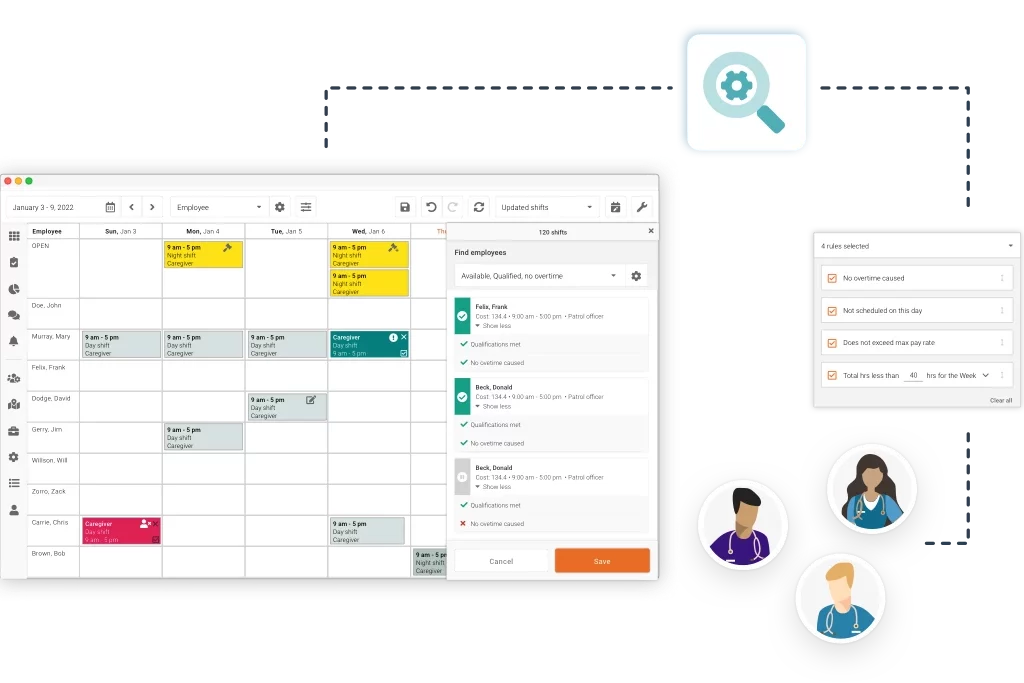While the vast majority of companies try to avoid overtime in their shift schedules, this isn’t always possible. This is especially true for 24/7 operations such as hospitals, security guard firms, manufacturing or hospitality.
In these cases, the schedulers’ goal is generally to keep overtime at a minimum, and distribute overtime fairly. Sometimes, there aren’t enough employees/resources to match the amount of work that needs to be done. As a manager, it’s your job to assess if additional talent is needed, or if overtime can be used effectively to fill in the gaps.
Being able to distribute that overtime fairly is the key to effective workforce management. This can sometimes be referred to as overtime equalization.
What is overtime equalization?

Overtime equalization is the practice of fairly distributing available overtime across a workforce or pool of employees. This is important for many reasons. First, its important to provide workers with fair and equal opportunity to extra shifts.
In fact, this is a critical element of effective employee scheduling. So, why else is it so important to distribute overtime fairly, and how do you go about determining overtime equalization?
Why it’s important to distribute overtime fairly.
58% of hourly workers are likely to leave their current employer over unfair scheduling practices.
Satisfied Workforce
Imagine there are 2/3 employees who get assigned all of the overtime shifts over a period of time. There is no question that this will lead to issues and conflict. First, you’ll have the employees getting no opportunity to work these shifts complaining.
You will also have the employees who are being given the shifts complain that they are working more than everyone else, despite the monetary bonus. If a scheduler can distribute overtime fairly, there will be no jealousy or bitterness between employees.
Avoid Burnout
As you can imagine, if a group of employees are often given overtime shifts, it’s only a matter of time before they burn out. Burnout is a real issue in 24/7 industries and can lead to serious accidents, injuries and even health issues. Burnout can be easily avoided with fair overtime distribution, as all employees take on a fraction of the extra workload, rather than a small number of employees taking it all on.
Union Agreements

It’s very common for any industry/company operating in the shift work or 24/7 operations space have unions to protect their workers. Most overtime union agreements outline some form of overtime equalization policies. However, these policies generally only apply when it comes to planned overtime.
Yes, some companies actually design their schedules and shift patterns to include overtime! So, unplanned overtime, which is becoming more common, adds a new level of complexity. So, it’s important for schedulers to have their own internal practices around distributing overtime fairly.
Attracting & retaining talent
Regardless of your industry/shift patterns, being able to attract and retain your talent is essential. Research has found that 58% of hourly workers are likely to leave their current employer over unfair scheduling practices. Of course, overtime equalization is a key component of scheduling practices, and something to be considered when it comes to morale and retention.
Challenges to Distributing Overtime Fairly
So, as a manager or scheduler, the burden of distributing overtime fairly falls to you. Generally, they manage a complex set of business and overtime rules to track a range of stats for each employee. To help with this, schedulers often use a set of sorting criteria in order to help distribute overtime fairly. These include:
- Hours already scheduled/worked in pay period
- Overtime hours balance
- Latest overtime shift worked/refused
- Overtime refusal balance
- Seniority
- Year-to-date hours worked
- Job classifications
- Employee rotation order (generally pre-defined)
When you see the criteria and factors that go into overtime distribution, you can see how tedious and time consuming it can be. All of the factors above accumulate a large amount of ever-changing data. Not only is this difficult, it’s extremely error-prone.
These errors impact employees, who might ultimately file a complaint or involve their union steward to resolve the matter. That’s a mess that schedulers want to avoid. So, what can they do to help the distribute overtime fairly, and efficiently?
Using Workforce Management Software to Distribute Overtime Fairly

We’ve talked about the benefits of workforce management software at length here at Celayix. In fact, we consider ourselves experts in the field. Workforce management software (such as Celayix employee scheduling software) can help managers distribute overtime fairly. Celayix uses an advanced rules-based engine to alleviate the manual sorting of the data above.
With Celayix, employers can specify job classifications when onboarding new employees, which can help with fair overtime distribution. They can also create lists based on seniority, department or any other criteria as needed. When creating business rules, then can also create very specific rules around overtime distribution which can help to ensure it’s done fairly.
The scheduler can then create the schedule as they want, assigning all shifts to employees as normal. When it comes to assigning and filling in overtime shifts, they can use the Autofill function, or Celayix AI to recommend a best fit employee based on qualifications and current overtime assignments.
They can then apply your rules to determine which employees are used for the next overtime assignment. This saves time, money and effort when creating an employee schedule with overtime. Automation improves speed and accuracy, leading to optimized schedules in a matter of minutes.
If you’d like to learn more about how Celayix can help you distribute overtime fairly, contact us today or start a free trial!





